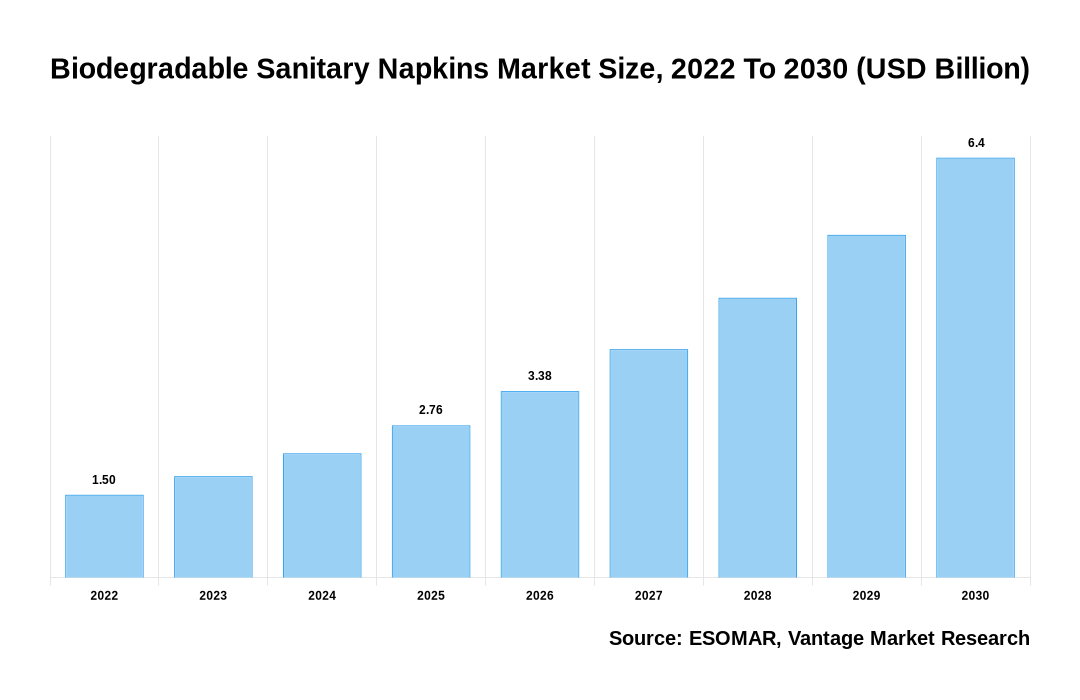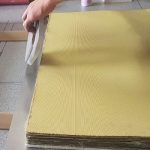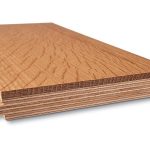Global Biodegradable Sanitary Napkins Market
As stated in our extensive report; the Global Biodegradable Sanitary Napkins market accounted for 1.5 Billion in the year 2022 and is projected to reach a value of USD 6.4 Billion by 2030.
A lady uses sanitary napkins, which are absorbent items when she is menstruating. They are either made of synthetic or chemical-based raw materials, such as plastics and non-biodegradable cellulosic fiber, or they are made of natural materials that decompose over time, such as banana fiber, bamboo maize, organic cotton, etc. The usage of potentially harmful chemicals and raw materials in conventional sanitary napkins has stoked curiosity among female users of biodegradable sanitary napkins. The use of biodegradable raw materials in sanitary pads is being influenced by rising environmental consciousness. The market for biodegradable sanitary napkins is expanding globally due to factors such as the rising number of working women, rising awareness of female hygiene, and rising health concerns like skin irritation and rashes. Chemicals including dioxins, furans, chlorine, and perfumes are used in non-biodegradable sanitary products, which are bad for the environment and cause skin issues.
Menstrual hygiene is a serious issue globally, where women, particularly in rural regions, have difficulty finding hygienic absorbents and run the danger of developing health problems. Awareness of the advantages provided by biodegradable sanitary napkins has significantly increased over time. They are simply disposed of on bare soil and are environmentally friendly.
Click To Get a Free Sample On the Research Study

On the other hand, biodegradable sanitary products contain components like banana fiber, maize starch, water hyacinth, organic cotton, etc. that are cozy, hygienic, economical, and effectively absorb blood. Increasing levels of knowledge, government initiatives, and schemes, better distribution networks, etc. are some of the key variables influencing this market.
Key factors influencing Biodegradable Sanitary Napkins Market Growth
- The use of biodegradable raw materials in sanitary pads is also being influenced by growing environmental consciousness.
- Materials like banana fiber, maize starch, water hyacinth, organic cotton, etc. are used to make biodegradable sanitary napkins.
- Chemicals including dioxins, furans, chlorine, and perfumes are used in non-biodegradable sanitary products, which are bad for the environment and cause skin issues.
- The market for biodegradable sanitary towels is expanding as a result of rising health concerns such as skin rashes and irritation.
- Sanitary napkins are simply disposed away in uncultivated soil and are environmentally sustainable.
North America Region to Lead the Market
The market is divided into five regions based on geography: North America, Europe, Asia Pacific, Latin America, and the Middle East and Africa (MEA). Canada and the United States are two more of the nations that make up North America. The continent of Europe is divided into the United Kingdom, France, Germany, Italy, Spain, Russia, and the Rest of Europe. China, Japan, South Korea, India, Australia, South East Asia, and the Rest of Asia Pacific comprise the second division of the Asia Pacific region. Brazil, Mexico, and the Rest of Latin America are subdivided into separate regions within that continent, and the GCC, Turkey, South Africa, and the Rest of the MEA are separate regions within that continent.
Conclusion
Increasing Awareness to Protect the Environment is Also Driving the Adoption of Biodegradable Raw Materials in Sanitary Napkins.
Some of the key players in the Global Biodegradable Sanitary Napkins market include- Bamboo Babe, Carmesi, Delipap Oy, EnviroBren, Heyday, Natracare, Planera, Plastfree and others.
![[Market Research Reports] – Research Google News Blog | VMR.Biz](https://www.vmr.biz/wp-content/uploads/2022/12/logo-removebg-preview.png)











